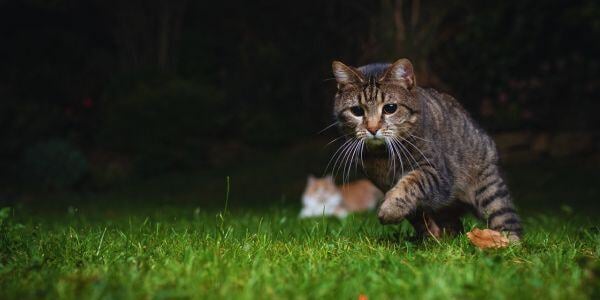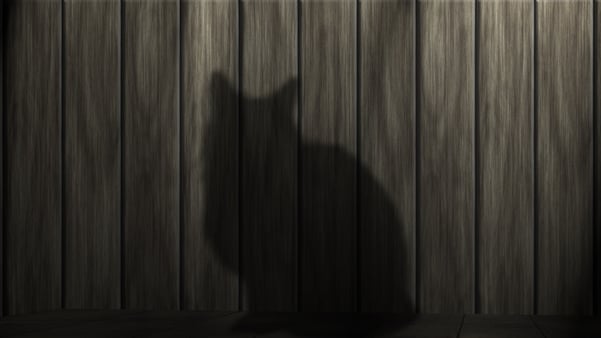
If you have an indoor/outdoor cat, a barn cat, or even just a neighborhood kitty, you might be curious about what they’re doing after dark and while the world sleeps.
What Cats Are Doing at Dusk and Dawn
You may have visions of furry feline predators on the hunt for the perfect prey, under the light of the moon. You’d be half right if you’re talking about dusk to late-night, and also very early morning.
Cats hunt birds, insects, snakes, lizards, and rodents. These critters are most active at dusk and dawn. Even though cats hunt throughout the day, their hunting behavior is likely to peak when their prey is out doing their own hunting and gathering.
A cat who prefers birds may be more active in the early morning, whereas a mouse-hunting cat will be actively hunting at night.
Don’t think that, just because your cat is well fed inside, they won’t hunt when they’re outside. It’s not only about hunger for cats. Hunting is an instinctual need. It’s vital for survival, but also … they enjoy it, as the cats in Athens show us later in this article.
What Cats Are Doing in the Middle of the Night
Are cats nocturnal? You may be surprised to learn they’re not.
Nocturnal means they’re most active at night, as in through the middle of the night.
Cats are actually crepuscular, meaning they’re most active at dusk and dawn. They will spend most of the late-night hours sleeping, unless they’re in a situation that doesn’t allow them to sleep or doesn’t feel safe.
Just like people, your cat’s internal clock can shift. People who work nights can learn to sleep during the day and eat breakfast when the rest of us are having dinner.
If your cat’s internal clock seems off — maybe they’re waking you up at 3am ready to play or asking for food — you may just need to get them back into their natural rhythm of being up during the day, active, and having a snack right before bed and first thing in the morning.
What Cats Do at Night When They're Not Hunting
Cats do more than hunt when they’re outdoors. They also explore and investigate.
There may be areas that your cat can’t go during the day (like the neighbor’s yard with the loud kids or a dog) that feel safer to explore in the evening.
There may be a cranky tomcat who rolls through at 5am, so they get out of the area by 4:30am.
They’re climbing trees, looking for high perches and hiding spots, smelling all the smells, playing, and of course, trying to stay safe. We’ll talk more about safety after a quick trip to Athens.

The Cats of Athens, Georgia
Researchers from the University of Georgia (UGA) were curious about after-hours cat behavior. So, they employed some technology, strapping cameras to 55 outdoor cats in Athens, and reviewed their nighttime antics.
The researchers (and the cat parents) were surprised to learn that the Athens outdoor cats preferred hunting small reptiles and amphibians, or small local mammals (voles) over mice.
What’s more, the cats’ hunting wasn’t what you might call productive. The monitored cats left behind about half of the animals they hunted (meaning they killed or severely injured them and left them to die), only ate about 28%, and brought home about 23%.
That just goes to show how important and instinctual the act of hunting is for cats. It’s not just about hunger. It’s in their DNA.
Check out this UGA page to view videos of these cats.

Cat Safety at Night
There are a lot of potential dangers for your cat outside, especially at night.
During their nightly exploits, the cats in the UGA study had a habit of putting themselves in danger.
Overall, 85% of the cats did at least one thing the researchers deemed a dangerous behavior!
The top dangerous behaviors for those cats were:
- Crossing roads (45%)
- Encountering strange cats (25%)
- Eating and drinking substances away from home (25%)
- Exploring storm drain systems (20%)
- Entering crawlspaces where they could become trapped (20%)
Safety isn't just about cats engaging in risky behavior. Their instinctual behavior can also be dangerous in this day and age. Simple things like hunting prey, for example, increases the risk of exposure to avian influenza, parasites, and even second-hand poisoning from rodents who ate poison from bait stations.
Check out our article on nighttime safety if your cat is allowed outdoors after the sun goes down.

Bringing Outdoor Activities Inside
Now you can take what you’ve learned about your cat’s outside activities and see if you can come up with fun new ways to replicate those behaviors inside.
We have a great article on how to recreate your cat’s natural hunting sequence with a wand toy. Da Bird is the best wand toy, in my opinion.
There are lots of different DIY mental and physical enrichment activities and toys you can try. We list some of our favorite food puzzles and other toys in our article.
If you’re curious about your cat’s wanderings or if you want to keep track to avoid losing them if they spend time outdoors, you might consider a GPS collar. In the video below, you can get an idea of what one cat did for about 12 hours during the day when its activity was tracked.
Cats Fighting at Night
Cat fights can be awful. Two cats will usually get very vocal first — yowling, hissing, growling — in an attempt to avoid a physical confrontation. If that doesn’t work, they do what they need to do to protect themselves. That may mean a knockdown, drag-out fight.
Cats can fight any time of day or night. It’s more common when an unneutered male is involved. But any two cats can feel threatened by each other, leading to a fight.
If your cat has been fighting with area cats, it may be time to reconsider letting them outside, or perhaps changing the times that they’re out in an effort to avoid the other cats.
You can also look at humane deterrents to keep other cats out of your yard, like motion-activated sprinklers.
If your cat comes home with a bite or any other injury, a vet visit is crucial to avoid infection. Learn about cat bite abscesses and how they can develop without there being a visible wound.
If your cat is declawed, it's best not to let them outside unsupervised, day or night. Declawing removes one of their primary defensive weapons, leaving them open to attack from other cats and predators.
Sounds Cats Make at Night
Aside from the obvious sound of a cat fight, one of the main times you’re likely to hear a cat is when they want to be heard, like when they’re looking for food or a mate. The video below includes an example of cat mating sounds. You might also enjoy the other videos compiled by Meowsic (think “music” combined with “meow”), a research group that is studying the ways cats communicate with each other — and with us.
There’s no end to the ways these creatures can fascinate us. The more we learn about them, the more we want to know. Cats are incredible!
Note: Preventive Vet recommends that cats not be let outside without direct observation. This is for their own health and safety, as well as the health and safety of other animals in your neighborhood and even you and the other members of your home (cats can pick up zoonotic diseases that they can transfer to humans or bring back fleas and other parasites).
If this sounds like a good enough reason to transition your outdoor kitty to an indoor lifestyle, we’ve got you covered with our article on How to Make an Outdoor Cat and Indoor Cat.




